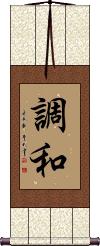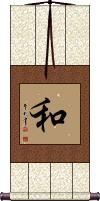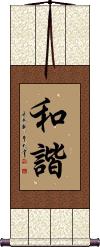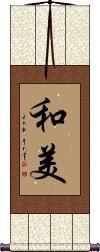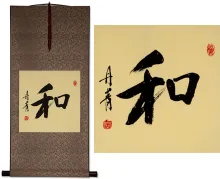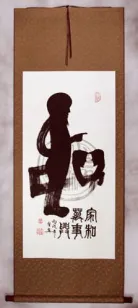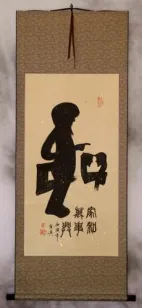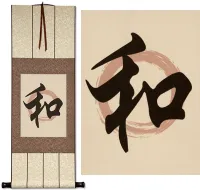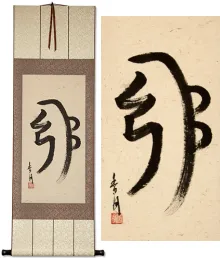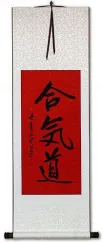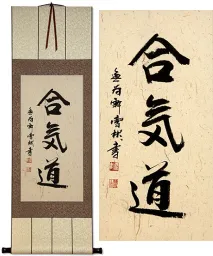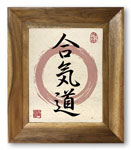Many custom options...
And formats...

Harmony in Chinese / Japanese...
Buy a Harmony calligraphy wall scroll here!
Personalize your custom “Harmony” project by clicking the button next to your favorite “Harmony” title below...
Life in Harmony / Balanced Life
調和生活 is a Japanese title that suggests that you have, or want to get your life in balance.
The first two Kanji mean harmonious or in harmony.
The second two Kanji mean “life.” More specifically this refers to your livelihood, career, and the daily activities that comprise your life or living.
Life in Harmony / Balanced Life
Harmonious Life
This 和諧生活 title suggests that you have, or want to get your life in balance.
The first two characters regard the idea of balance, harmony, and peace.
The second two characters mean “life.” More specifically this refers to your livelihood, career, and the daily activities that comprise your life or living. Some would translate those two characters as “one's daily existence.”
Note: We have a couple of titles for this idea. This version is more of a noun, thus "The Balanced Life" verses a verb form like "Balancing [Your] Life."
Perfect Harmony
琴瑟和鳴 is a Chinese title that means “in perfect harmony” or “in sync.”
This can translate as “two harps in harmony.” While this more literally means “qin [and] se harmonious sound.”
The qin and se are both types of string instruments (Chinese zithers) that are known to play in perfect harmony. Thus, the two together are often used as a metaphor for marital harmony or a happy marriage.
Harmony / Balance
Cho Wa
調和 is one of the several ways to express harmony in Chinese and Japanese.
Note: The first character means harmony but also suggests a musical meaning. It can also describe warriors marching in perfect cadence (in step) or to regulate something.
The second character carries the meaning of harmony and peace by itself.
Together, these characters create a word that can be defined as harmonious, to mediate, to reconcile, to compromise; mediation, temper, to mix, blend, blended, season, seasoning (getting the flavors of the food in balance), to placate, or be in harmonious proportion.
The meaning varies depending on the context. However, when hanging as a wall scroll, this will refer to the person (you) being balanced and in harmony while rational and under control simultaneously.
Peace / Harmony
和 is the simplest form of peace and harmony.
和 can also be translated as the peaceful ideas of gentle, mild, kind, and calm. With a more harmonious context, it can be translated as union, together with, on good terms with, or on friendly terms.
Most people would just translate this character as peace and/or harmony. 和 is a very popular character in Asian cultures - you can even call it the “peace symbol” of Asia. In fact, this peace and harmony character was seen repeatedly during the opening ceremony of the 2008 Olympic Games in Beijing (a major theme of the games).
In old Chinese poems and literature, you might see this used as a kind of "and." As in two things summed together. As much as you could say, "the sun and moon," you could say "the sun in harmony with the moon."
See Also: Inner Peace | Patience | Simplicity
Harmony / Balance
Beautiful Life / Life in Perfect Harmony
和美 is a word that means “harmonious” or, “in perfect harmony.”
The deeper meaning or more natural translation would be something like, “beautiful life.”
The first character means peace and harmony.
The second character means beautiful. But in this case, when combined with the first character, beautiful refers to being satisfied with what you have in your life. This can be having good relations, good feelings, comfort, and having enough (with no feeling of wanting).
Note: In Japanese, this is often used as the name "Wami." This title is probably more appropriate if your audience is Chinese.
This in-stock artwork might be what you are looking for, and ships right away...
Blemished Peace / Harmony Special Calligraphy Scroll
Discounted Blemished
Gallery Price: $53.00
Your Price: $29.00
Gallery Price: $53.00
Your Price: $29.00
Gallery Price: $90.00
Your Price: $49.88
Gallery Price: $40.00
Your Price: $16.88
Gallery Price: $60.00
Your Price: $36.88
Gallery Price: $300.00
Your Price: $109.88
Gallery Price: $87.00
Your Price: $47.88
Gallery Price: $60.00
Your Price: $36.88
Not the results for harmony that you were looking for?
Below are some entries from our dictionary that may match your harmony search...
| Characters If shown, 2nd row is Simp. Chinese |
Pronunciation Romanization |
Simple Dictionary Definition |
和 see styles |
huò huo4 huo wataru わたる |
More info & calligraphy: Peace / Harmony(1) (mathematics term) sum; (2) harmony; peace; (n,n-pref,adj-no) (3) Japan; Japanese-style; (noun or adjectival noun) (kana only) soft; fragile; weak; poorly built; insubstantial; (adj-nari) (archaism) tranquil; calm; quiet; peaceful; calm (at sea); lull; (given name) Wataru Harmony, peace; to blend, mix; with, unite with; respond, rhyme. |
呼吸 see styles |
hū xī hu1 xi1 hu hsi kokyuu / kokyu こきゅう |
More info & calligraphy: Breathe(n,vs,vt,vi) (1) breathing; respiration; (2) knack; trick; secret (of doing something); (3) harmony; balance; synchronization; accord; (4) (See 一呼吸) short interval; short pause Exhale and inhale. |
和合 see styles |
hé hé he2 he2 ho ho wagou / wago わごう |
More info & calligraphy: One Mind / Unity(n,vs,vi) harmony; concord; agreement; unity; union; (place-name, surname) Wagou To blend, unite, be of one mind, harmonize. |
和美 see styles |
hé měi he2 mei3 ho mei wami わみ |
More info & calligraphy: Beautiful Life / Life in Perfect Harmony(surname, female given name) Wami |
和諧 和谐 see styles |
hé xié he2 xie2 ho hsieh wakai わかい |
More info & calligraphy: Harmony / Balance(1) {law} harmonious divorce settlement; (2) (archaism) harmony; reconciliation; accord |
均衡 see styles |
jun héng jun1 heng2 chün heng kinkou / kinko きんこう |
More info & calligraphy: Balance / Equilibrium(n,vs,vi) balance; equilibrium |
調和 调和 see styles |
tiáo hé tiao2 he2 t`iao ho tiao ho chouwa / chowa ちょうわ |
More info & calligraphy: Harmony / Balance(n,vs,vi,adj-no) harmony; accord; reconciliation; agreement; (personal name) Chōwa to adjust |
和敬清寂 see styles |
wakeiseijaku / wakesejaku わけいせいじゃく |
More info & calligraphy: Elements of the Tea Ceremony |
琴瑟和鳴 琴瑟和鸣 see styles |
qín sè hé míng qin2 se4 he2 ming2 ch`in se ho ming chin se ho ming |
More info & calligraphy: Perfect Harmony |
ハーモニー see styles |
haamonii / hamoni ハーモニー |
More info & calligraphy: Harmonie |
倭 see styles |
wō wo1 wo yamato やまと |
dwarf; Japanese (derog.) (old) (1) (mathematics term) sum; (2) harmony; peace; (n,n-pref,adj-no) (3) Japan; Japanese-style; (1) Yamato; ancient province corresponding to modern-day Nara Prefecture; (2) (ancient) Japan; (can act as adjective) (3) Japanese; (surname, given name) Yamato |
叶 see styles |
xié xie2 hsieh you / yo よう |
to be in harmony (surname) Yō |
怡 see styles |
yí yi2 i i |
harmony; pleased happy |
悌 see styles |
tì ti4 t`i ti yasushi やすし |
to do one's duty as a younger brother (1) respect for one's elders; (2) harmony among siblings; (given name) Yasushi obedient |
燮 see styles |
xiè xie4 hsieh |
to blend; to adjust; to harmonize; harmony |
融 see styles |
róng rong2 jung ranzou / ranzo らんぞう |
to melt; to thaw; to blend; to merge; to be in harmony (personal name) Ranzou Blending, combining; melting, thawing; clear intelligent. |
雍 see styles |
yōng yong1 yung you / yo よう |
harmony (given name) Yō |
上下 see styles |
shàng xià shang4 xia4 shang hsia jouge / joge じょうげ |
the top and bottom of something; the full vertical extent of something; from top to bottom; to go up and down; before and after (as in 上下文[shang4 xia4 wen2] "context"); (used after a quantity) approximately; ... or so; (in a social hierarchy) the high and the low; seniors and juniors (as in 上下和睦[shang4 xia4 he2 mu4] "harmony between superiors and subordinates"); all members of a group (as in 舉國上下|举国上下[ju3 guo2 shang4 xia4] "the entire nation"); relative superiority (as in 不相上下[bu4 xiang1 shang4 xia4] "evenly matched") (1) top and bottom; high and low; above and below; upper and lower ends; up and down; (n,vs,vi) (2) going up and down; rising and falling; fluctuating; (n,vs,vi) (3) going and coming back; (4) upper and lower classes; ruler and ruled; the government and the people; (5) first and second volumes; (6) {cloth} top and bottom; two-piece (outfit); (place-name, surname) Jōge above and below |
不調 不调 see styles |
bù tiáo bu4 tiao2 pu t`iao pu tiao fuchou / fucho ふちょう |
(n,adj-no,adj-na) (1) bad condition; poor condition; disorder; slump; being out of form; (noun or adjectival noun) (2) failure; rupture; breakdown (e.g. of negotiations) out of harmony |
二和 see styles |
èr hé er4 he2 erh ho futawa ふたわ |
(place-name) Futawa The double harmony or unity, i. e. 理 and 事, indicating those who are united in doctrine and practice, or the saṅgha. |
五逆 see styles |
wǔ nì wu3 ni4 wu ni gogyaku ごぎゃく |
(1) {Buddh} five cardinal sins (killing one's father, killing one's mother, killing an arhat, shedding the blood of a Buddha, causing a schism within the sangha); (2) (hist) crime of killing one's master, father, grandfather, mother, or grandmother pañcānantarya; 五無間業 The five rebellious acts or deadly sins, parricide, matricide, killing an arhat, shedding the blood of a Buddha, destroying the harmony of the sangha, or fraternity. The above definition is common both to Hīnayāna and Mahāyāna. The lightest of these sins is the first; the heaviest the last. II. Another group is: (1) sacrilege, such as destroying temples, burning sutras, stealing a Buddha's or a monk's things, inducing others to do so, or taking pleasure therein; (2) slander, or abuse of the teaching of śrāvaka s, pratyekabuddhas, or bodhisattvas; (3) ill-treatment or killing of a monk; (4) any one of the five deadly sins given above; (5) denial of the karma consequences of ill deeds, acting or teaching others accordingly, and unceasing evil life. III. There are also five deadly sins, each of which is equal to each of the first set of five: (1) violation of a mother, or a fully ordained nun; (2) killing a bodhisattva in a sangha; (5) destroying a Buddha's stūpa. IV. The five unpardonable sin of Devadatta who (1) destroyed the harmony of the community; (2) injured Śākyamuni with a stone, shedding his blood; (3) induced the king to let loose a rutting elephant to trample down Śākyamuni; (4) killed a nun; (5) put poison on his finger-nails and saluted Śākyamuni intending to destroy him thereby. |
写り see styles |
utsuri うつり |
(n,n-suf) (1) projection; reflection; image; reception (e.g. TV); picture quality; (2) match; harmony |
凡響 凡响 see styles |
fán xiǎng fan2 xiang3 fan hsiang |
ordinary tones; everyday harmony; common chord |
協和 协和 see styles |
xié hé xie2 he2 hsieh ho kyouwa / kyowa きょうわ |
to harmonize; harmony; cooperation; (music) consonant (n,vs,vi) concord; harmony; concert; (place-name, surname) Kyōwa |
協調 协调 see styles |
xié tiáo xie2 tiao2 hsieh t`iao hsieh tiao kyouchou / kyocho きょうちょう |
to coordinate; to harmonize; to fit together; to match (colors etc); harmonious; concerted (n,vs,vi) cooperation; conciliation; harmony; coordination |
口和 see styles |
kǒu hé kou3 he2 k`ou ho kou ho kuchiwa くちわ |
(place-name) Kuchiwa Harmony of mouths or voices, unanimous approval. |
和声 see styles |
wasei; kasei / wase; kase わせい; かせい |
(noun - becomes adjective with の) {music} harmony; concord; consonance |
和敬 see styles |
hé jìng he2 jing4 ho ching wakei / wake わけい |
(given name) Wakei reverent harmony |
和楽 see styles |
waraku わらく |
(n,vs,vi) peace and harmony; (surname) Waraku |
和睦 see styles |
hé mù he2 mu4 ho mu waboku わぼく |
peaceful relations; harmonious (n,vs,vi) reconciliation; peace; rapprochement Concord, harmony. |
Click here for more harmony results from our dictionary
The following table may be helpful for those studying Chinese or Japanese...
| Title | Characters | Romaji (Romanized Japanese) | Various forms of Romanized Chinese | |
| Life in Harmony Balanced Life | 調和生活 | cho wa sei katsu chowaseikatsu | ||
| Life in Harmony Balanced Life | 和諧生活 和谐生活 | hé xié shēng huó he2 xie2 sheng1 huo2 he xie sheng huo hexieshenghuo | ho hsieh sheng huo hohsiehshenghuo |
|
| Perfect Harmony | 琴瑟和鳴 琴瑟和鸣 | qín sè hé míng qin2 se4 he2 ming2 qin se he ming qinseheming | ch`in se ho ming chinsehoming chin se ho ming |
|
| Harmony Balance | 調和 调和 | chou wa / chouwa / cho wa | tiáo hé / tiao2 he2 / tiao he / tiaohe | t`iao ho / tiaoho / tiao ho |
| Peace Harmony | 和 | wa | hé / he2 / he | ho |
| Harmony Balance | 和諧 和谐 | hé xié / he2 xie2 / he xie / hexie | ho hsieh / hohsieh | |
| Beautiful Life Life in Perfect Harmony | 和美 | wa mi / wami | hé měi / he2 mei3 / he mei / hemei | ho mei / homei |
| In some entries above you will see that characters have different versions above and below a line. In these cases, the characters above the line are Traditional Chinese, while the ones below are Simplified Chinese. | ||||
Successful Chinese Character and Japanese Kanji calligraphy searches within the last few hours...



